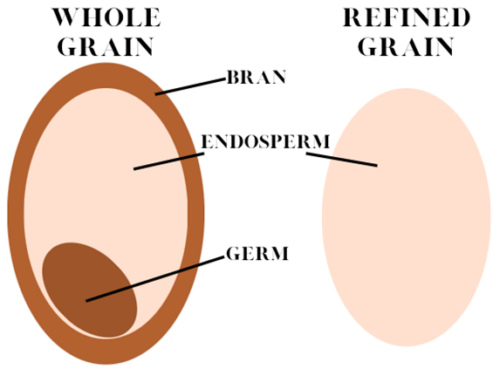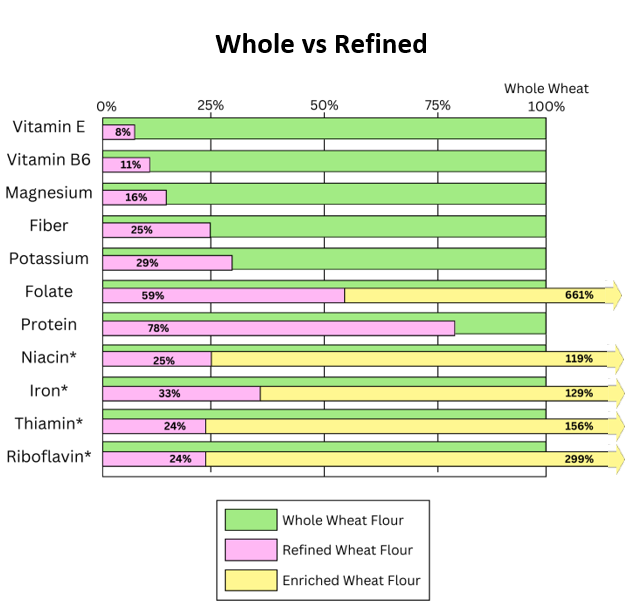Understanding Whole Grains

Whole grains are complex carbohydrates comprising three integral components:
- Bran: The fiber-rich outer layer that supplies B vitamins, iron, copper, zinc, magnesium, antioxidants, and phytochemicals.
- Germ: The nutrient-dense core containing healthy fats, B vitamins, vitamin E, phytochemicals, and antioxidants.
- Endosperm: The interior starchy part of the grain containing some vitamins and minerals.
Consuming all three parts provides a “complete package” of health benefits, unlike refined grains that are stripped of valuable nutrients during processing.
Examples of Whole and Refined Grains
- Whole Grains: Whole wheat, whole oats, quinoa, popcorn, brown rice, barley, and rye.
- Refined Grains: White bread, white rice, and white pasta.
Refined grains undergo milling, a process that removes the bran and germ, leaving only the starchy endosperm. This not only gives grains a finer texture and longer shelf life but also strips away dietary fiber, iron, and many B vitamins.
Health Benefits of Whole Grains
Incorporating whole grains into your diet offers numerous health advantages:
- Reduced Risk of Chronic Diseases: Regular consumption of whole grains is associated with a lower risk of stroke, type 2 diabetes, heart disease, and colorectal cancer.
- Weight Management: The fiber content in whole grains aids in better weight maintenance by promoting satiety and reducing overall calorie intake.
- Improved Digestion: Whole grains support healthy digestion and reduce the risk of constipation.
Identifying Whole Grain Products
Navigating the grocery store to identify whole grain products can be challenging due to misleading labels:
- Terminology: Terms like “wheat bread” or “multigrain” don’t necessarily indicate whole grain content. Always check the ingredient list for “whole wheat flour” or “whole grain flour” as the primary ingredient.
- Color Misconceptions: The color of bread isn’t a reliable indicator of its whole grain content. Some manufacturers use caramel coloring or molasses to give bread a darker appearance, mimicking whole grain products.
- “Enriched” Labels: Products labeled as “enriched” have had certain nutrients added back after refining but still lack the full nutritional profile of whole grains. The term “enriched” signals that nutrients have been added back in after the refining process.
Making Informed Choices
To ensure you’re selecting genuine whole grain products:
- Read Ingredient Lists: The first ingredient should be a whole grain, such as “whole wheat flour.”
- Look for Certifications: Seek out products with certifications or stamps indicating 100% whole grain content.
- Be Skeptical of Marketing Claims: Don’t rely solely on front-of-package claims like “multigrain” or “made with whole grains.” These can be misleading.
By understanding the components and benefits of whole grains, you can make informed dietary choices that contribute to overall health and well-being.
Sources:
Harvard T.H. Chan School of Public Health. (n.d.). Whole grains. The Nutrition Source. Retrieved March 6, 2025, from https://nutritionsource.hsph.harvard.edu/what-should-you-eat/whole-grains
U.S. Department of Agriculture. (n.d.). Grains. MyPlate. Retrieved March 6, 2025, from https://www.myplate.gov/eat-healthy/grains
Whole Grains Council. (n.d.). What are the health benefits of whole grains? Retrieved March 6, 2025, from https://wholegrainscouncil.org/whole-grains-101/health-studies-health-benefits
American Heart Association. (n.d.). Whole grains, refined grains, and dietary fiber. Retrieved March 6, 2025, from https://www.heart.org/en/healthy-living/healthy-eating/eat-smart/nutrition-basics/whole-grains-refined-grains-and-dietary-fiber


